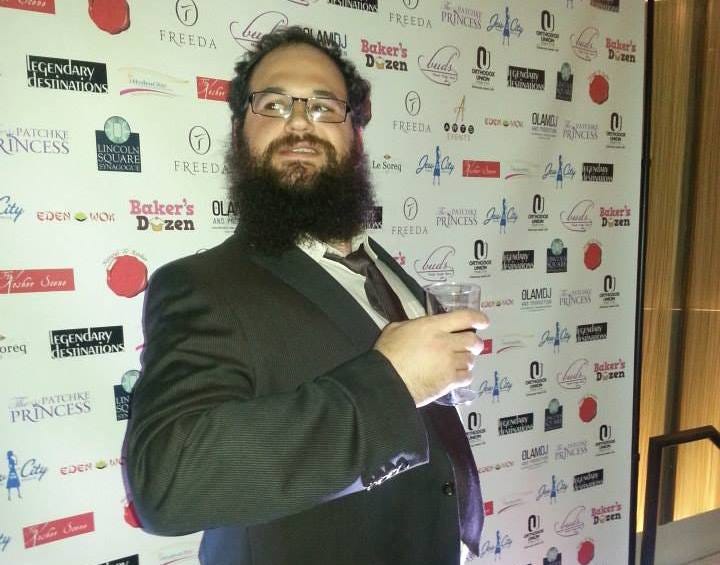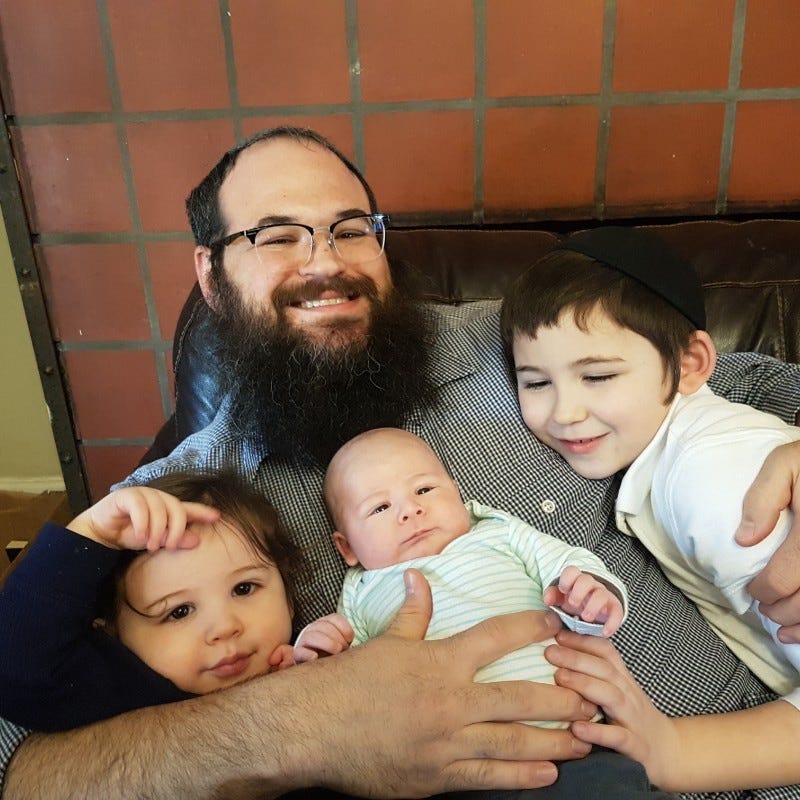Chassidic Jewish television writer has learned to accept religious institutionalism “warts and all”
Meet Dov Ber Naiditch, head writer at a major India-based animation company.
For as long as Dov Ber Naiditch can remember, he wanted to teach English like his mom, who recalls his using “big dictionary” words even as a kid.
“We had a huge library with shelves and shelves of secular and sacred books, from the Soncino Talmud to Shakespeare,” said the Pittsburgh-based Naiditch, a chassidic Jew and head writer at Green Gold Animation. “I’d spend long Shabboses [Sabbaths] reading whatever looked interesting.”
As he grew up, Naiditch grew increasingly drawn to writing as a profession, so he earned an M.F.A. in creative writing. “I wrote, and still write, these tiny, little stories about mystical things happening to normal people,” he said.
Naiditch’s name came to my attention recently when I happened to see the closing credits of a show my toddler was watching. (He knows his way around Netflix better than I, so he chooses what he watches.)
It turned out to be “Mighty Little Bheem,” and beside a roaring tiger, I saw one Rajiv Chilaka was creator, producer and director; Krishna Mohann Chintapatla was co-director and animation director; and several other names followed that I guessed were Indian. But then DovBer Naiditch appeared under “screenplay,” sandwiched between Juhi Sneh (creative coordinator) and Tirthadip Ghosh (storyboard artist).
I figured there must be a story here—to the writer with a chassidic name. So there is.
Born in Minnesota, Naiditch—the fourth of eight boys—has lived most of his life in Pittsburgh. Both of his parents found their way to Orthodox Judaism through the chassidic movement Chabad Lubavitch. Naiditch’s father was a manager of the kosher kitchen at Pittsburgh’s Montefiore Hospital, and his mother taught English at religious yeshiva schools.

Naiditch married and began raising a family. “As you may know, a degree in the arts doesn’t get you a cup of coffee, much less milk and cookies for the kids,” he said. His wife is a nurse, and he took up odd jobs before co-founding a production company with friends that made “funny Jewish philanthropy dinner videos and commercials.”
Through a friend of a friend, he connected with Marc Lumer, an L.A.-based children’s book artist, and the two collaborated on “Babel.” When Lumer landed a job with India’s largest animation company, Green Gold Animation, he asked Naiditch to join.
At Green Gold, Naiditch started writing for “Mighty Little Bheem”—the show my toddler was watching—a spinoff of the country’s most popular show, “Chhota Bheem.”
“It’s about a kid with super strength,” Naiditch said. “Netflix and Green Gold wanted to bring him to other markets without abandoning his India fans, so we settled on a baby-centered prequel in the form of a non-dialogue show in the vein of ‘Road Runner’ and ‘Tom and Jerry.’ It’s pretty popular worldwide, and I’m proud to say I wrote a majority of the shows.”
Since joining Green Gold, Naiditch has written for the PBS affiliate children’s show “Sounder & Friends,” which teaches phonics, and is pitching his own shows to networks.
Asked about his religious journey, Naiditch said, “That’s a doozy.”
“I usually say I’m religious, because I was raised right. I was born into an ultra-Orthodox chassidic environment, but because of my parents’ background and my awareness of the broader western weltanschauung, I was always at the borders of both,” he said. “I think that’s a good place to be. It gives you a perspective on both cultures.”
He grew up in a home with tolerant parents, who made clear how they wanted their children to grow. “They encouraged questions and tried to provide answers,” Naiditch said. “They were open about their own experiences.”
A “few rough years” as a teenager showed him his capacity to hurt his parents, and despite issues with Orthodoxy, he didn’t want to pain his parents by leaving the tradition in which he grew up. “Not for the ephemeral pleasures of a cheeseburger,” he said. “I knew enough at least to know I didn’t really know anything, not at 15.”
He opted to “stay within the boundaries” in which he was raised, even as he fought them. Some of his brothers chose to leave Orthodoxy. “We’re all still close, except for the crappy ones,” he said. “They know who they are.”
And Naiditch’s “rebel-without-a-cause” teenage years soon gave way to his own understanding of his place within religion, which he could explore on his own terms.
“It’s institutionalized, yes, and anachronistic, and parts are pathological, but my God, it’s like a grand old dilapidated castle, and I’d been pointing at the mold in the basement but never bothered to look at the upper floors,” he said. “So I gained something like a foundational, personal interest in religious practice as a thing that provided meaning and value to me in the moment, despite my skepticism.”
In his 30s, Naiditch has come to understand better his place across time, as a religious person transmitting both knowledge and meaning from the past to the future.
That led him to accept Orthodox institutionalism even, “warts and all,” he said. “I desire meaning, and despite spending an inordinate amount of time watching bad zombie movies and joking about flatulence with friends, here I’ve somehow come to find it.” (At 38, he looks forward to what he will discover in his 40s.)
So what does it mean to be a chassid, and in particular, a chassidic artist?
To Naiditch, the former reflects yearning for “ecstatic communion with God, and achieving that through mystical understanding of how mundane actions are really sublime moments of union with the Godhead.”
Marriage here is a metaphor, to Naiditch; while every husband has to pitch in on chores, a chassid would understand (or hope to grasp) the ways that every folded shirt, mowed lawn, and tightened door knob deepens his connection with his wife.
There are other aspects, he said, but that’s the most fundamental. “It’s a pretty high level. How many of us can do that, or sustain that feeling?” he said. “So we mostly outsource it to a charismatic leader and let him do the heavy lifting.” (That would be the chassidic Rebbe.)
Naiditch, of course, doesn’t pretend to speak for all chassidic writers, and being a chassid who writes for popular television isn’t a different job than being a non-chassid who writes for popular television. The principle is the same: “Find a potential hero, challenge him, challenge him again, watch him emerge victorious having learned something new,” he said.
But that changes when Naiditch writes about his own community.
“Here my tone is more affected by a postmodern tradition of skepticism and suspicion of reason and authority, coupled with magical realist narratives that are very comfortably intertwined with a tradition of chassidic tales,” he said. These kinds of stories are more fun to write, but are harder, and there’s no obvious audience for them.
When he’s at work, Naiditch enjoys playing with stereotypes.
“It’s fun to watch confused faces in meetings as I enter, and then see those same faces light up when I make a ‘Star Trek’ reference or joke about Tik Tok,” he said. “I can’t say I mean to teach anything. But to me it’s its own tiny story in one meeting. You meet someone with expectations, and you come out of it with an expanded view of the world. You see someone different and realize you’re also the same.”
“I think it’s like a more advanced version of talking about the weather with someone on an elevator,” he added. “You walked in as two strangers, and now you’re walking out as a community of people, who agree it’s been really humid all week.”
Naiditch finds his Indian colleagues particularly undisturbed about his appearance. He figures they are exposed to a broader range of cultural norms and practice, and they also navigate a new American milieu. “I’m just one more different thing,” he said.
Stateside, Naiditch tries to “get it out there early that I’m different and I know it.” That might be joking about how many kids he has, talking about Hollywood needing more Jews, or the like. He’s almost always happy to answer genuinely curious questions.
But his religious identity and its conspicuous nature are also obstacles. There are certain cultural associations that people have with his name and appearance, which he feels the burden to overcome or undermine. (Luckily, he believes in burdens, both as a Jew and storyteller. “Burdens make for better characters,” he said.)
Writing children’s stories, Naiditch appreciates that the stakes are high, but not too high, and the archetypal personalities are fun.
“I’m still enamored enough with the medium to enjoy playing around in it,” he said.
He’s also shopping around a collection of magic realist short stories about chassidic Jews. “I get very nice rejections about how it’s beautiful but unsellable,” he said.







